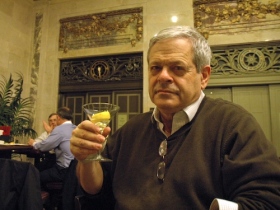I’m going to be writing a lot in the days and weeks to come about the fun new “Chasing Dreams: Baseball & Becoming American” exhibit at the National Museum of American Jewish History in Philadelphia and its companion book, a lovely anthology.
To kick things off, and in recognition of the NCAA basketball tournament, here’s a “Greatest Jewish Ballplayer” bracket as designed by Daniel Okrent.
 Among his many other career highlights, Okrent founded the award-winning New England Monthly and was chief editor of Life and was also the first public editor of The New York Times. On television, he has appeared as an expert commentator on many network shows, and talked more than any other talking head in Ken Burns’ Baseball miniseries.
Among his many other career highlights, Okrent founded the award-winning New England Monthly and was chief editor of Life and was also the first public editor of The New York Times. On television, he has appeared as an expert commentator on many network shows, and talked more than any other talking head in Ken Burns’ Baseball miniseries.
Okrent is the editor/author of several baseball books, including The Ultimate Baseball Book, Nine Innings, American Pastimes: The Very Best of Red Smith, and Baseball Anecdotes.
And last, but certainly not least, he is considered by many to be the founding father of what has now morphed into the multi-billion dollar industry of fantasy sports.
Okrent sent along these responses to some of my queries about his quirky Jewish baseball bracket via e-mail.
* * *
 Click on image to enlarge.
Click on image to enlarge.
Kaplan: As you say in the bracket’s intro, the ballplayers are “great, good, decent, or barely adequate major league Jews.” How did you pick them? What was your criteria?
Okrent: The really good players were there because they’re really good. The others made it because they made good copy; there were stories behind them. Adam Greenberg, of course, is the outstanding example.
Kaplan: The piece was adapted from a 2009 book, The Final Four of Everything. Is there more of an explanation there?
Okrent: Not really. The editors of that book, which is a collection of similarly off-the-wall brackets, asked me to contribute; I picked the subject. My favorite other entry in the book was a bracket determining the greatest invention in history. The winner was “sliced bread.”
Kaplan: Is there any “science” in this at all, or purely personal preference on your part?
Okrent: Purely, deeply personal.
Kaplan: Just like the NCAA brackets are discussed almost as much for who was left off than who was included, have you gotten  any feedback about some of your selections?
any feedback about some of your selections?
Okrent: Surprisingly, no. Except one friend who was disappointed that I didn’t include Joe Ginsberg.
Kaplan: There are obviously elements of fantasy at work here. Did you ever think some 30 years ago, a bunch of folks sitting around a restaurant table would have devised something that has blossomed into a multi-billion industry? Are you thrilled by it because it has been so widely embraced or appalled because a pleasant past time has turned into such a business?

Kaplan: Is it true that you came up with the statistics we now know as WHIP (walks plus hits per inning)? When do you think that will show up on baseball cards? Unless it already has; I stopped collecting several years ago.
Okrent: I did; it was one of the original categories in the original Rotisserie League, in 1980. I had kept track of something similar playing Strat-O-Matic baseball. No idea about the baseball cards.
Kaplan: Do you still enjoy baseball as much as you did when you were a kid? After talking with John Thorn [Major League Baseball’s official historian and a consultant for the Museum’s project] at the media preview for the Chasing Dreams exhibit, I inexplicably began to question why I still follow the game. After all, can people of our age consider kids in their 20s (and 30s) our “heroes?” And if we’re only thinking about those heroes from our youth — and before (Ruth, Gehrig, Mays, etc.) — what does that say about our ability to live in the present?
Okrent: I’m back to enjoying it as much, after many years of being a little put-off by it, back when I was writing about it, I had vocationalized a passion when I should have left it as it was, something nearer to my heart than to my wallet.
* * *
 Dan Okrent and John Thorn will sit down for a chat at NMAJH on Tuesday, March 25, just a couple of “Old Jews Talking Baseball.” For more information, click here.
Dan Okrent and John Thorn will sit down for a chat at NMAJH on Tuesday, March 25, just a couple of “Old Jews Talking Baseball.” For more information, click here.
















Comments on this entry are closed.